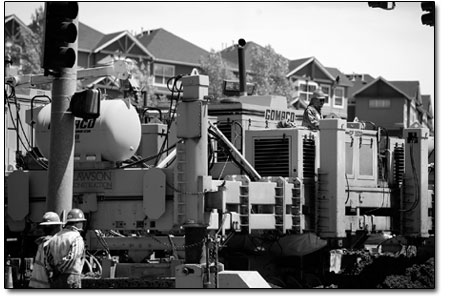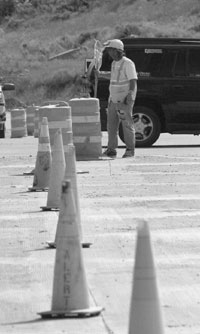|
| ||||
| Inside the cone zone
by Jeff Mannix
Add a few bumper-to-bumper creep-alongs, throw in occasional stop-and-waits, mix in lane switches every couple of days, heavy equipment bearing down only inches away, dust, human stop signs and blinking lights and the result: road rage, at least in some degree, by just about everyone. The concrete highway paving project around Bodo Park – expanding the roadway by two lanes, improving intersections, upgrading signals, widening shoulders, installing storm drains, reclaiming sod dividers and resurfacing 2½ miles of U.S. highways. 550/160 – has been stressful for Durango motorists for the past 12 months. When it’s all finished next month, and drivers glide along on state-of-the-art pavement, it won’t take two weeks before the driving public forgets the inconvenience of navigating for a year through a work in progress. Now that motorists can see the light at the end of this tunnel du jour, it isn’t too late, while the construction is still an annoyance, to examine what has taken place over the past year at a cost of $14 million. Lawson Construction Co. is a concrete paving firm from Longmont and a prominent company in the field, employing more than 100 people during peak construction periods. Working for the Colorado Department of Transportation (CDOT), an army of 50 Lawson concrete formers and pavers arrived in Durango last July atop three computer-controlled concrete spreaders, valued at $2 million each; a platoon of front loaders and backhoes; a dozen mixer trucks; road graders; steamrollers; and 30 other specialized machines and trucks. A year’s worth of engineering preceded the invasion, 32 subcontractor companies were engaged, and signal poles, immense storm water pipes and thousands of tons of cement and aggregate were ordered. Offices were leased and a 2-acre concrete batch plant was constructed almost overnight to supply spreader machines capable of laying down a quarter mile of 36-foot lanes a day, far more concrete than all local companies combined could deliver. Military references are not hyperbole: the planning, logistics, span of control, synchronization, critical path and maximum use of resources are much like doing battle. Lawson’s Senior Project Manager Brian Erickson’s desk and office in the Red Cedar building next to Home Depot is strewn with invoices, work orders and plans. His telephones don’t stop ringing, especially the two cell phones he often has to his head at the same time. “This is a medium-sized job for us, but it’s a complicated one,” Erickson reports. “We’re the general contractor on this job – usually we’re subcontractors doing concrete paving only,” he says. “The requirements for this job include 2 miles of 24-inch to 84-inch storm drain pipes for Bodo Park, four intersections with 15 new light poles, a few dozen local and Front Range contractors, material transport, and what we knew could turn into a traffic nightmare Mark Garcia, a grizzled bantamweight with 35 years in concrete paving experience, is Lawson’s superintendent. “We come to a job with an experienced, professional crew and the best equipment in the business,” he says. “We knew the challenges of this job before we arrived, so we hit the ground running with a plan that we hoped would speed things up and cause the least inconvenience to the public – we’ll be done four months early, on budget and, from what I’ve heard from motorists, with tolerable disruption.” The materials, manpower and engineering used in the construction around Bodo are indeed impressive. More than 130,000 square yards of concrete were used on this roadway – that’s 35,000 cubic yards, or 1.4 million pounds. By comparison, if you were to have a mixer truck deliver concrete to your site, the truck would hold 8 cubic yards and would cost you $850.
The Lawson workers have been working 60- to 70-hour weeks, staying in local motels and returning to their homes in the Denver area for a weekend – usually a holiday with an extra day or two – then they’re back on the job in Durango for another month or more. Owner Ken Lawson transports his employees from job to home and back again with an over-the-road bus. “These workers have been with me for 15, 20, 35 years; they support families and send kids to college. They spend a lot of time away from their families, and when they get to go home, they’re tired and in no shape to drive through the mountains. We’re a family, and we take care of each other.” Subcontractors are scheduled as work progresses. The timing is critical; crews cannot stand idle while waiting for subs to arrive or complete their work. “It costs me $2,000 an hour to have my crew in place,” says Garcia, “and as we get to the end of a job, when 50 things aren’t happening at the same time, we sometimes have to pull off onto another job so the subs can catch up. I’ll send a crew back to form and finish islands and construct the median once the signal poles are in place and wired.” Western States Reclamation from Loma, Colo., is doing all the mulching and seeding of the disturbed roadside. “Basically we’re farmers,” says General Supervisor Steve Hale. “We’re the largest reclamation company in the Intermountain West, and we work from the Midwest to California on big jobs only.” Hale says his company uses the latest technology of hydromulching and hydroseeding, all sprayed from its 12,000 gallon tanker trucks. All of their fertilizer and soil amending products are organic, and the cover blanket is weed-free wheat straw. “We plant native grasses and shrubs, and while it may take some of these grasses two years to reach maturity, we expect nearly 100 percent growth.” The lane striping is done by Branson Traffic Control, a La Plata County company, and according to owner Tom Branson, “We’re not painting stripes on this project; we’re inlaying reflective tape. That’s 25 miles of tape, inset one-eighth of an inch to save them from snowplows, then glued down.” That’s about a semi-truck flatbed of rolls of tape and hundreds of hours gouging up eighth-inch strips. “We could have painted the whole thing in the time it will take us to prepare a single stripe,” says Branson, “but we’re told that it should last a lot longer than paint. We’ll see; I think 3M has a good lobby,” Branson says with a wink. And what about those hideous traffic barrels? Alert Traffic Control is responsible for weaving and reweaving traffic through this ever-changing landscape. “We have 510 traffic drums onsite,” says comptroller Robert Holmes. Each costs about $50 and is placed according to the “Manual on Uniform Traffic Devices.” Spacing is determined by traffic speed and they can have as many as 12 flaggers and dozens of specific signs on the stretch at any given time. And for those who see red every time they see an orange barrel, Holmes reminds them that they are not alone. “Every driver is irritated when we come upon road construction,” he says, “even me.” •
|



 It’s become a conditioned reflex, as certain as Pavlov’s dog salivating at the chime of Ivan’s bell: Put up enough reflective traffic cones, and drivers immediately secrete indignation.
It’s become a conditioned reflex, as certain as Pavlov’s dog salivating at the chime of Ivan’s bell: Put up enough reflective traffic cones, and drivers immediately secrete indignation.